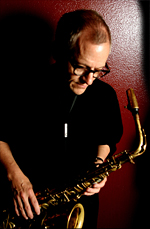 |
 |
||||||||||||||||
The Inspiration for the Luther Hughes Ensemble is Divine
What is there to say about a jazz group founded upon the inspiration of a single classic recording? That was the question posed by the performance of the Luther Hughes Cannonball-Coltrane Project on Wednesday at Jazz at the Westin Lobby Court. In one of the more quixotic notions in recent jazz, bassist Hughes was so taken by a 1959 LP - "The Cannonball Adderley Quintet in Chicago" (also re-released as "Cannonball and Coltrane") - that he decided to assemble a similarly instrumented quintet, playing music from, and stimulated by, the recording. The original LP featured alto saxophonist Julian "Cannonball" Adderley and tenor saxophonist John Coltrane - two jazz icons - in their sole recorded partnership (other than their outings with the Miles Davis sextet), which made Hughes' challenge daunting. But the Hughes ensemble - including alto saxophonist Bruce Babad and tenor saxophonist Glenn Cashman, pianist Ed Czach and drummer Paul Kreibich - has done a credible job of reviving a period in which jazz was moving from the fiery, hard bop of the late '50s into the envelope-stretching adventures of the '60s. Hughes wisely chose to approach the project from the perspective of inspiration rather than simulation. The group's performance featured one number from the actual recording - a steaming, up-tempo romp through "Limehouse Blues" that allowed Babad and Cashman to display their fluid, fast-fingered improvisational skills. The balance of the set included a mixed bag of standards ("On Green Dolphin Street"), jazz classics (Nat Adderley's "Work Song") and originals (Hughes' "Herôis" and Kreibich's "Partido Mar Vista") underscoring Hughes' desire to stay within the stylistic orbit of the recording. Most jazz repertory groups tend to focus on music for large ensembles - big-band sounds. And there's a lot to praise in the overviews of Duke Ellington, Count Basie, Charles Mingus, etc., provided by organizations such as the Lincoln Center Jazz Orchestra, the Mingus Big Band and the Frank Capp Juggernaut. Unfortunately, the music of the multiplicity of memorable small ensembles has tended to receive less attention. Which makes Hughes' Cannonball-Coltrane Project one of the more compelling entities on the jazz scene - a model for the possible repertory revival of such unique groups as the Raymond Scott Quintette, the Modern Jazz Quartet, the George Russell Sextet, Weather Report and Return to Forever, to name only a few of the period-defining possibilities. | ||||||||||||||||